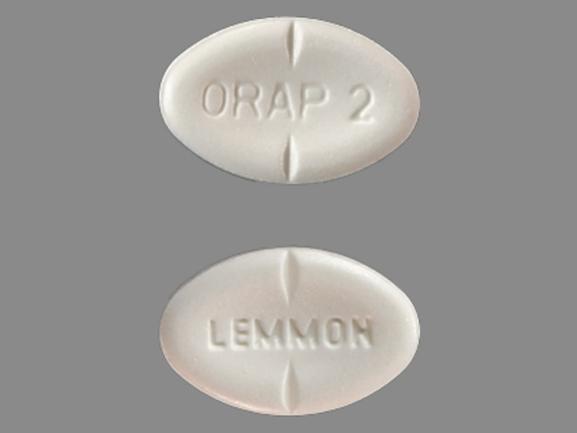Orap and Alcohol/Food Interactions
There is 1 alcohol/food/lifestyle interaction with Orap (pimozide).
Pimozide Food/Lifestyle
Major Food Interaction
GENERALLY AVOID: Theoretically, the coadministration with grapefruit juice may increase the plasma concentrations of pimozide. The mechanism is decreased clearance of pimozide due to inhibition of CYP450 3A4-mediated first-pass metabolism in the gut wall by certain compounds present in grapefruits. The use of pimozide alone has been associated with dose-dependent prolongation of the QT interval. Although clinical data are lacking, this interaction may result in potentiation of the proarrhythmic effect of pimozide and consequently an increased risk of ventricular arrhythmias such as ventricular tachycardia and torsade de pointes. In addition, alcohol may potentiate some of the pharmacologic effects of pimozide. Use in combination may result in additive central nervous system depression and/or impairment of judgment, thinking, and psychomotor skills.
MANAGEMENT: The manufacturer recommends avoiding grapefruit juice (and probably grapefruits) during therapy with pimozide. Patients should also be advised to avoid or limit consumption of alcohol.
References (2)
- "Product Information. Orap (pimozide)." Gate Pharmaceuticals
- Dresser GK, Spence JD, Bailey DG (2000) "Pharmacokinetic-pharmacodynamic consequences and clinical relevance of cytochrome P450 3A4 inhibition." Clin Pharmacokinet, 38, p. 41-57
Switch to consumer interaction data
Orap drug interactions
There are 754 drug interactions with Orap (pimozide).
Orap disease interactions
There are 18 disease interactions with Orap (pimozide) which include:
- dementia
- CNS depression/coma
- previous neuroleptic malignant syndrome (NMS)
- seizure disorders
- acute alcohol intoxication
- CNS depression
- NMS
- pituitary tumors
- QT interval prolongation
- tics
- seizure
- hyperprolactinemia/breast cancer
- neutropenia
- anticholinergic effects
- hyperprolactinemia
- parkinsonism
- tardive dyskinesia
- renal/liver disease
More about Orap (pimozide)
- Orap consumer information
- Check interactions
- Compare alternatives
- Reviews (17)
- Drug images
- Side effects
- Dosage information
- During pregnancy
- Drug class: miscellaneous antipsychotic agents
- Breastfeeding
Related treatment guides
Drug Interaction Classification
| Highly clinically significant. Avoid combinations; the risk of the interaction outweighs the benefit. | |
| Moderately clinically significant. Usually avoid combinations; use it only under special circumstances. | |
| Minimally clinically significant. Minimize risk; assess risk and consider an alternative drug, take steps to circumvent the interaction risk and/or institute a monitoring plan. | |
| No interaction information available. |
See also:
Further information
Always consult your healthcare provider to ensure the information displayed on this page applies to your personal circumstances.


